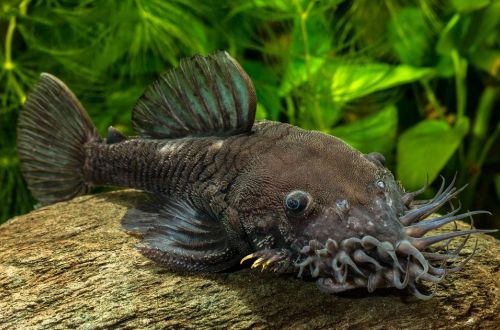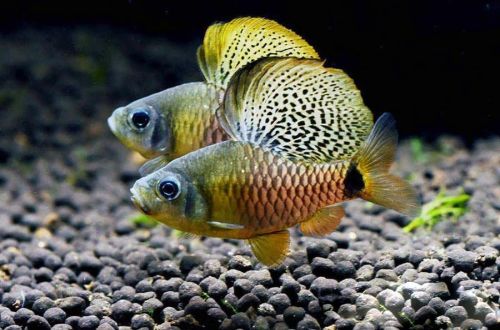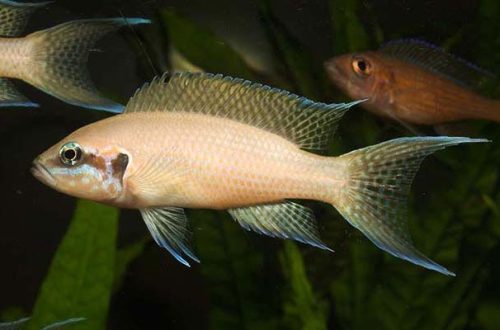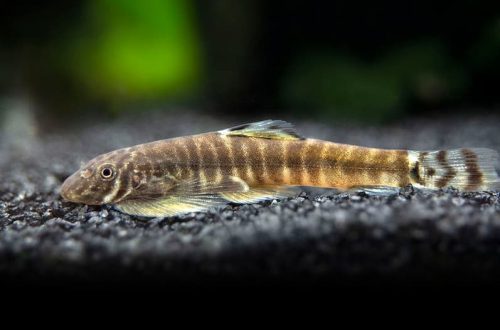
Ancitrus-jellyfish
Ancistrus ranunculus or Ancistrus jellyfish, scientific name Ancistrus ranunculus, belongs to the family Loricariidae (chain catfish). The unusual appearance of this catfish may not be to the taste of some aquarists, but on the contrary, it may seem very interesting to someone. This is not the easiest fish to keep. Probably, novice aquarists should look at other related species.

Contents
Habitat
They come from South America from the Tocantins river basin, located on the territory of the state of the same name in Brazil. Inhabits small fast-flowing rivers and streams, where it occurs among stony substrates.
Brief information:
- The volume of the aquarium – from 70 liters.
- Temperature – 23-28°C
- Value pH — 6.0–7.0
- Water hardness – 1–10 dGH
- Substrate type – sandy or rocky
- Lighting – any
- Brackish water – no
- Water movement – moderate or strong
- The size of the fish is 10–11 cm.
- Nutrition – high protein food
- Temperament – peaceful
- Content alone or in a group
Description
Adult individuals reach a length of 10–13 cm. The fish has a somewhat flattened body with a massive head. The body is covered in “armor” of hard plates, studded with sharp spines. The first rays of the ventral fins are thickened, turning into spikes. Coloring black monophonic. Sexual dimorphism is weakly expressed, there are no visible differences between male and female.
A characteristic feature of the species are numerous long outgrowths near the mouth, resembling tentacles. It is thanks to them that the catfish got one of its names – Ancitrus jellyfish. The tentacles are nothing more than antennae that help find food in turbulent streams.
Food
Unlike most other Ancitrus catfish, it prefers food rich in protein. The diet should consist of frozen brine shrimp, bloodworms, pieces of shrimp meat, mussels and similar products, as well as dry food based on them.
Maintenance and care, arrangement of the aquarium
The optimal size of the aquarium for 3-4 fish starts from 70 liters. Catfish is able to live in various conditions. This may be an environment that resembles a mountain river bed with a gravel or sandy substrate, large boulders, rocks with rounded edges, as well as the bottom of a swampy reservoir with an abundance of aquatic vegetation. The presence of natural or decorative shelters is welcome. In any case, Ancistrus ranunculus needs moderate water movement, and since not all plants are adapted to currents, careful attention should be paid to the choice of suitable varieties.
Successful long-term management largely depends on maintaining stable water conditions within an acceptable range of temperatures and hydrochemical values. To do this, regular maintenance procedures are carried out (replacement of part of the water with fresh water, waste disposal, etc.) and the aquarium is equipped with all the necessary equipment, primarily a productive filtration system. The latter also often provides internal movement of water.
Behavior and Compatibility
A peaceful, calm fish that prefers to stay in one place for a long time, for example, in its shelter. Compatible with other non-aggressive species of comparable size. Some territorial behavior is inherent in Ancitrus jellyfish, so make sure that everyone has their own secluded shelter.
Breeding / breeding
Breeding is considered quite a difficult task, especially for beginner aquarists. Adding to the problems is the lack of differences between the sexes, so it is impossible to say with certainty how many males and females are in the aquarium. To increase the chances of the appearance of at least one pair, at least 5 fish are purchased.
The best incentive for spawning is the establishment of favorable conditions: a diet rich in protein, vitamins and microelements, slightly acidic soft water with a temperature of 26–28 ° C, a high content of dissolved oxygen. With the onset of the mating season, males occupy the best shelters, which are caves or grottoes, and actively invite females to their place. Cases of skirmishes between males are not uncommon due to lack of space or a small number of partners. When the female is ready, she accepts courtship, swims to the male and lays several dozen eggs, after which she leaves. All responsibility, and future offspring, is borne by the male, protecting it from any potential danger, including from its own relatives. Care continues until the fry are able to swim on their own, usually taking about a week from spawning.
Fish diseases
The cause of most diseases is unsuitable conditions of detention. A stable habitat will be the key to successful keeping. In the event of symptoms of the disease, first of all, the quality of the water should be checked and, if deviations are found, measures should be taken to correct the situation. If symptoms persist or even worsen, medical treatment will be required. Read more about symptoms and treatments in the Aquarium Fish Diseases section.





